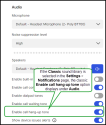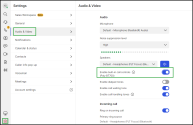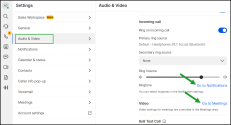Set up audio and video
Since various features of 8x8 Work for Desktop make use of your computer speakers, microphone, and camera, you can configure your audio settings as desired for calls, and select from your available devices to participate in meeting audio and video. You can also set the ring speaker and volume separately from your primary call audio. Let's say you want to avoid missing incoming calls when you're not wearing your headset: If you commonly use a headset, you can select the speaker an incoming call rings from.
When 8x8 Work for Desktop detects a new audio or video device, you are automatically asked whether you want to use it for application audio.
To access audio and video settings from the app:
- Go to Settings
 > Audio and video.
> Audio and video. - Select your desired media devices for audio and video. You can view the sensitivity of your microphone, test your speaker audio quality by clicking Test speakers
 next to your selected device, and enable or disable tones and alerts.
next to your selected device, and enable or disable tones and alerts.
To set the device for advanced call control:
8x8 Work supports advanced call control on all the devices supported by WebHID (Human Interface Device). WebHID integration allows you to control your calls without using a vendor-specific headset application, ensuring any WebHID is supported by 8x8 Work. That means the call control events, such as answer, hangup, volume, and mute, will be synchronized.
- Go to Settings
 > Audio and video.
> Audio and video. -
Switch ON the Enable built-in call controls toggle and select from the available HID devices list that displays the appropriate device for advanced call control.
Note: Built-in call control (answer, end call, and toggle mute) browser support is available on Chrome OS, Linux, macOS, and Windows. Select one of the available HIDs to enable this capability in your browser. If you want to select a different device, turn the toggle on and off again.
- Switch ON the Enable dial pad tones toggle to allow users to receive an acoustic feedback when entering a phone number in the dial pad. By default, the dial pad tones are disabled.
- Switch ON the Enable call waiting tone toggle to allow users to receive a waiting tone while on a call, informing them at regular intervals of incoming call. By default, the call waiting tone is enabled.
- Switch ON the Enable call hanging tone to allow users to receive a hang-up tone when one party puts the call on hold while on a call. By default, the hang-up tone toggle is enabled.
To set ring source for incoming calls:
- Go to Settings
 > Audio and video.
> Audio and video. - Plug in or pair your headset or secondary speakers.
-
Under Incoming call, you can choose whether incoming calls ring, and set the ring tone and ring volume. In addition, you can choose whether your computer remains your primary ring source.
Note: If the Citrix optimization is activated, you can choose a specific speaker to play the calling sounds and incoming ringtones. To learn how to set a specific speaker for incoming ringtones, see Set up a secondary ring source.
- Under Ringtone, click Go to Notifications, which leads you to the Notifications settings page. Here, you can select the ring tones as suits you best.
-
Under Video, click Go to Meetings, which leads you to the Meetings page. Here, you can control the settings for video meetings.
Notes:- If the Modern sound library is selected in the Settings
 > Notifications page, the classic Hang-up tone doesn’t play and the related Enable call hang-up tone option doesn’t display in the Audio & Video settings page. Instead the new Enable handling tones option displays.
> Notifications page, the classic Hang-up tone doesn’t play and the related Enable call hang-up tone option doesn’t display in the Audio & Video settings page. Instead the new Enable handling tones option displays.
- If the Classic sound library is selected in the Settings > Notifications page, the new Enable call hang-up tone option displays in the Audio & Video settings page and you can choose to play the hang-up tone when one party puts the call on hold.
> Notifications page, the new Enable call hang-up tone option displays in the Audio & Video settings page and you can choose to play the hang-up tone when one party puts the call on hold. 
-
Under Browser protocol handlers, click Register, which leads you to the Notifications settings page. Here, you can register 8x8 Work for Web to handle tel:// links and the 8x8 WebDialer integration
To learn more about using the click-to-call tel:// link protocol, see Use the click-to-call tel:// link protocol and 8x8 Web Dialer to initiate calls.


